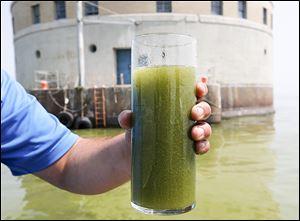
Study by UT details harm done by algae
Liver problems in mice accelerated by microcystin
8/18/2016Preliminary findings from a University of Toledo study on mice has researchers hoping to further study possible effects of microcystin on people with nonalcoholic fatty liver disease and other health conditions.
According to the study’s initial findings, mice that ingested microcystin — a toxin found in blue-green algae prevalent in Lake Erie algal blooms — had their existing liver damage exacerbated by accelerating fat accumulation on the liver along with inflammation.

A glass of algae-filled Lake Erie water.
“It suggests that further studies need to be done to see if humans are at the same risk,” said David Kennedy, assistant professor in the Division of Cardiovascular Medicine
Researchers from UT’s College of Medicine and Life Sciences used a dosage of microcystin known to be safe in healthy animals, he said. They wondered: How does the toxin at that level affect mice with already compromised health?
“We know that liver disease is a progressive disease. If you have excessive alcohol consumption ... diabetes, hypertension, all these things will cause this silent disease to progress into further liver damage,” he said. “We asked, ‘OK, is microcystin one of the hits that cause this progression?’ ”
Their preliminary results show it is.
Mr. Kennedy said their research should not draw red flags for Toledo water customers, as the dosage administered to the mice is much greater than the 1.6 parts per billion threshold the U.S. Environmental Protection Agency considers safe for drinking water.
“This is much higher than what is considered safe in the drinking water, a thousand times what is considered safe in the drinking water,” he said.
UT researchers are also collaborating with Wayne State University to create a blood test to detect microcystin, something that does not now exist. To do so, a standard must be identified for the approximately 80 variants of microcystin, Mr. Kennedy said.
“It’s exciting because no one else is doing this research,” he said. “Because of the grant we were able to provide something that is useful for health care providers.” Mr. Kennedy said the goal is to offer guidelines for medical professionals treating patients with fatty liver disease.
About one-third of adults in northwest Ohio have nonalcoholic fatty liver disease, Mr. Kennedy said, though it is often undiagnosed. Left untreated, the disease, often linked to excess weight and obesity, can lead to cirrhosis.
Over the course of a month the mice ingested microcystin-LR, the most common variety in western Lake Erie. But their research has implications beyond the region, Mr. Kennedy said.
“This problem is local and important to us, [but microcystin] is everywhere,” he said. “It’s just down the road in Grand Lake St. Marys. It’s in Florida, California, and China.”
Second year medical student Aaron Tipton helped design methods for the study and said working on the project expanded his own understanding of microcystin.
“It’s been enjoyable to work on a project that is close to home to Toledo,” he said.
Researchers plan to repeat their initial test and study the long-term effects of microcystin exposure in the mice. The $90,000 research project is funded through next summer by a $45,000 state grant, which was matched by UT.
Contact Lauren Lindstrom at llindstrom@theblade.com, 419-724-6154, or on Twitter @lelindstrom.